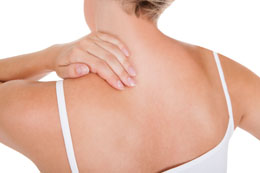Arthritis in the neck symptoms include severe neck and shoulder pain. The following article will cover information on the same in detail.

Stiffness in neck or pain in and around the neck and shoulder region is a common malady. This makes it extremely confusing to know whether it is a generalized pain or indication of arthritis. Arthritis is a common condition that affects people mostly over forty. Neck arthritis is one of its types, which obviously affects the neck region. It is also known as cervical osteoarthritis, cervical spondylosis, or degenerative joint disease of the neck. If you are trying to figure out the arthritis in the neck symptoms, go through the paragraphs below.
Symptoms
There are many reasons that can lead to this condition. Often, age-related degeneration of bones in the neck is a general cause. Your doctor will be able to correctly diagnose the cause. The normal wear and tear of bones leads to cervical spondylosis or osteoarthritis. Many times, osteoarthritis is accompanied by growth of bony spurs that leads to problems within the ligaments and disks of the neck. The most common signs of arthritis in neck include severe pain in neck and shoulder. Others include:
- Stiffness and pain in the neck
- Pain radiating in the arms
- Arms and hands numbness and weakness
- Weakness in legs that causes problems while walking or balancing
- Clicking or grinding sounds in neck
- Headaches
- Fatigue
- Muscle spasms in neck
- Sleeping disorders
- Limitation in moving or rotating head or neck around or bending the head sideways
Problems
Apart from limiting your head and neck movements, this disorder gives rise to a number of other problems. These include upper back pain, shoulder pain, and arm pain. Other problems are as follows:
Rheumatoid Arthritis
This inflammation is caused by an autoimmune disorder that affects the joints. The signs occur when the joints in the neck are destroyed. This leads to severe stiffness with pain. This is usually seen in the upper neck area.
Spondylosis
The cervical disc is like a shock absorber between the bones of the neck. When this disc degenerates, the space between the vertebrae is narrowed leading to stress on the joints of the spine. This causes further degeneration and may even cause the cervical disk to protrude. This causes pressure on the spinal cord and is known as herniated cervical disk or spondylosis.
Treatment
If diagnosed on time, it does not mean that you have to take medications for life. Nowadays, there are many natural treatments available that help in pain management. You may have to cut down on smoking, as it causes degenerative diseases to accelerate. You will also have to avoid activities that put strain on the neck and reduce weight if one is overweight, as a part of the treatment.
Medical treatment involves restriction of the neck movement with a cervical collar. If the collar is not sufficient to provide relief as well as support, a neck brace may be fitted. Non steroidal anti-inflammatory drugs (NSAIDs) like
aspirin, acetaminophen, ibuprofen, etc., may be prescribed. These medications help in controlling the swelling as well as other signs. A severe episode may be treated with steroid epidural that is injected in the affected part directly.
If the pain is too severe and is not controllable with medications as well as braces, surgery maybe performed. Also, if a patient suffers from neurological defects that lead to indications, like difficulty in walking, total weakness in hands, and bladder problems, surgery is considered. You can speak to your doctor about the signs and look for suitable pain management in the treatment options.
Disclaimer:
This Buzzle article is for informative purposes only, and should not be used as a replacement for expert medical advice.


 Stiffness in neck or pain in and around the neck and shoulder region is a common malady. This makes it extremely confusing to know whether it is a generalized pain or indication of arthritis. Arthritis is a common condition that affects people mostly over forty. Neck arthritis is one of its types, which obviously affects the neck region. It is also known as cervical osteoarthritis, cervical spondylosis, or degenerative joint disease of the neck. If you are trying to figure out the arthritis in the neck symptoms, go through the paragraphs below.
Stiffness in neck or pain in and around the neck and shoulder region is a common malady. This makes it extremely confusing to know whether it is a generalized pain or indication of arthritis. Arthritis is a common condition that affects people mostly over forty. Neck arthritis is one of its types, which obviously affects the neck region. It is also known as cervical osteoarthritis, cervical spondylosis, or degenerative joint disease of the neck. If you are trying to figure out the arthritis in the neck symptoms, go through the paragraphs below.